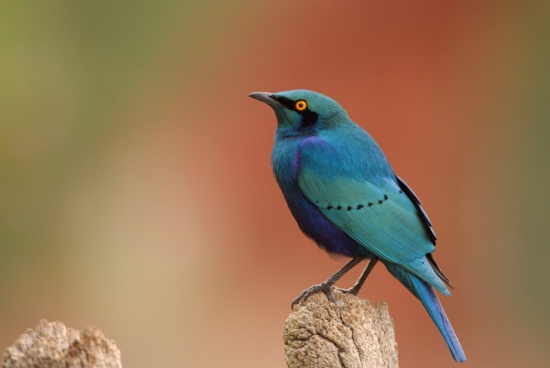Alternative name: Lesser Blue-eared Glossy Starling
- Lamprotornis chloropterus
Includes: Southern Blue-eared Glossy-Starling or Miombo Blue-eared Starling
Identification
Length 18-20 cm. A fairly small glossy starling with a relatively short tail.
Very similar to other Glossy Starlings.
- Glossy blue-green plumage
- Some dark spots near tips of uppertail-coverts
- Blackish lores and ear-coverts, the latter with blue gloss
- Blue-green wings with dark velvety spots at tips of median and greater coverts and tertials
- Glossy blue-green tail
- Violet-blue flanks, thighs and centre of belly
- Orange-yellow eyes
- Black bill and legs
Sexes similar.
Distribution
From Senegal east to Sudan, South Sudan, western Eritrea, Ethiopia, Uganda and Kenya. From there south to Tanzania, Mozambique and Zimbabwe.
Locally common in its wide range.
Taxonomy
Lamprotornis chloropterus has two subspecies:1
- L. c. chloropterus
- L. c. elisabeth
Habitat
Woodland and wooded savanna.
In most of its range in lowlands, in Kenya above 1000m, in the south of its range mainly above 800m.
Behaviour
Diet consists of fruit, seeds, nectar and insects (including beetles, termites, grasshoppers).
Forages in trees and on the ground. In pairs during breeding time, in small flocks otherwise often with Purple Glossy Starling and Greater Blue-eared Starling.
Breeding season differs through range. Presumably a monogamous species. The nest is placed in a tree hole. Lays 2-5 eggs.
A resident species in many areas, though some populations (for example in northern Sudan) move south at the end of the rainy season.
References
- Clements, J. F., T. S. Schulenberg, M. J. Iliff, D. Roberson, T. A. Fredericks, B. L. Sullivan, and C. L. Wood. 2017. The eBird/Clements checklist of birds of the world: v2017, with updates to August 2017. Downloaded from http://www.birds.cornell.edu/clementschecklist/download/
- Del Hoyo, J, A Elliott, and D Christie, eds. 2009. Handbook of the Birds of the World. Volume 14: Bush-shrikes to Old World Sparrows. Barcelona: Lynx Edicions. ISBN 978-8496553507
- Gill, F and M Wright. 2008. Birds of the World: Recommended English Names. Princeton University Press, Princeton NJ, USA. 2006. ISBN 9780691128276. Update (2008) downloaded from http://worldbirdnames.org/names.html.
- Hockey, PAR, WRJ Dean, and PG Ryan, eds. 2005. Roberts' Birds of Southern Africa. 7th ed. Cape Town: John Voelcker Bird Book Fund. ISBN 978-0620340533
- Sinclair, I and P Ryan. 2003. Birds of Africa South of the Sahara. Princeton: Princeton Univ. Press. ISBN 978-0691118154
Recommended Citation
- BirdForum Opus contributors. (2025) Lesser Blue-eared Starling. In: BirdForum, the forum for wild birds and birding. Retrieved 11 May 2025 from https://www.birdforum.net/opus/Lesser_Blue-eared_Starling




